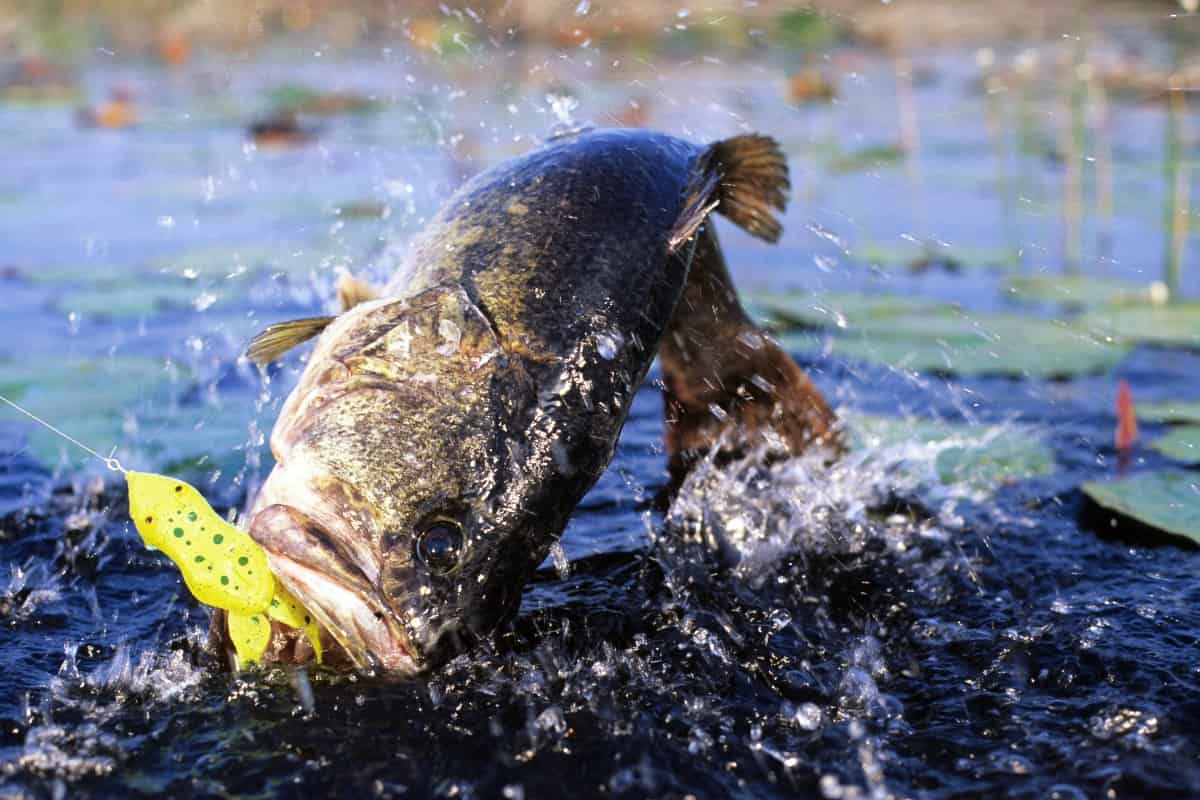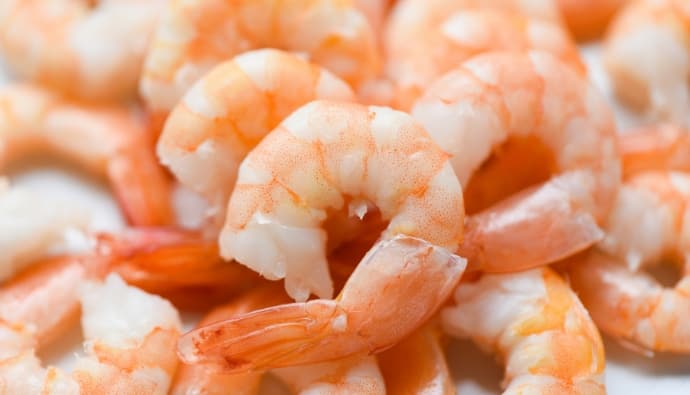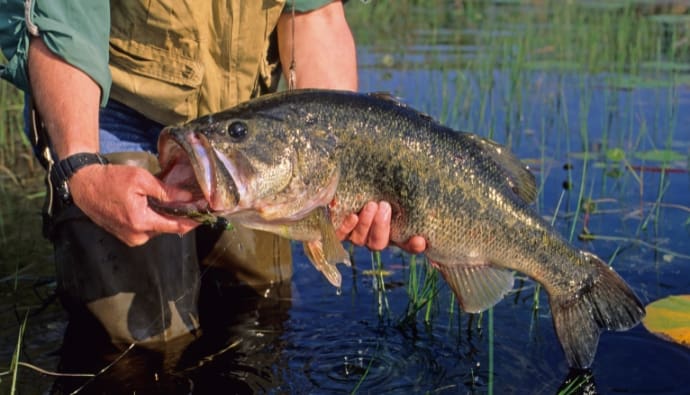Hooks in sizes 1/0 to 3/0 are typically appropriate for largemouth bass fishing. However, there are a few additional factors to take into account when selecting the proper hook size for the bass fishing type you engage in, including the hook type, the bass size you are after, and the kind of lure or bait you are employing.
On the other hand, a small fishing hook can easily be swallowed by fish, leading to gut hooking, which can result in the death of the fish. Likewise, incorrect hook designs will decrease your chances of catching largemouth bass.

Hook Sizing
It can be challenging to understand fishing hook sizes. All hook producers do not conform to the exact sizing standard. But many hook manufacturers follow a particular sizing guideline in their company, making it simpler for anglers to choose the right hook size for their next purchase.
The size of fishing hooks is categorized using one or two numbers. The smallest hook’s size the manufacturer makes is 32, while the largest hook size would be 1.
Fishing hook sizes can also be classified in an “aught designation” besides being listed from 32 to 1. In this instance, a hook represented as 19/0 would be more significant than 5/0. When displaying hooks in aught designation, the bigger the number, the bigger the hook size.
Hook Styles for Largemouth Bass
Although there isn’t an industry-wide standard for bass fishing hooks, most of the bass respond best to hook sizes ranging from 4 to 1 or 1/0 to 6/0 in aught classification. Regarding thickness, this is a matter of individual taste, which is slightly influenced by the kind of bait you intend to use.
Small fish hook sizes are ideal for simple live bait like grubs and worms, while small lizards, whole nightcrawlers, and soft plastic bass baits work better with large hook dimensions.
Since many basses are vigorous eaters and typically respond to various lure types, the style or kind of your fishing hook is not a significant consideration. You do not need to spend money on a unique hook for bass fishing.
Baitholder hooks, typical straight long shank hooks, or any thinner wire hook are suitable for basic fishing. The main worry is that it can fit into the fish’s mouth and has a sharp point ideal for setting a solid hook.
How to Select the Appropriate Fishing Hook Sizes
When using large hooks, anglers need to make sure the hook is extensive to handle the bait and catch the fish. Too-small hooks won’t be able to grip the trick or have enough barbs and points exposed to capture a fish. There’s a good chance you’ll merely lose your bait and catch nothing.
When choosing the best size, you can also consider the style of the hook. Some hooks are explicitly designed to accommodate substantial live or artificial baits while still leaving enough room for a fish to bite. Other hooks rely on perfectly formed bait to be effective.
Thick vs. Thin
Hooks come in various wire gauges, which significantly affects how difficult it is to bend them. The most expensive hook may look like what you desire, but that’s not necessarily the case. The term “gauge” refers to wire thickness. As the wire thickness increases, so do the number rise.
You can catch all freshwater bass species using typical thickness hooks. You will still have a big catch if you employ a light wire and a smaller fishing hook size. However, if you intend to land saltwater bass, larger bass, or other trophy species, make sure you choose a higher gauge wire.
Consider casting a light wire hook while fishing in areas where you are likely to become tangled. You’ll be able to pull yourself free when that thin wire bends. After you have the hook back in your hands, it is easy to shape it again. Thin wire hooks are simpler to use on live bait as they keep them active and moving for an extended period.
Straight Shank Hooks
Straight shank hooks are the most popular and widely used type of fishing hook. Straight shanks are the standard J-shaped hooks and are ideal for all kinds of bait, especially live bait, including crawfish and nightcrawlers.
Straight shank hooks are an excellent option for anglers fishing in foliage and cover. You can also use a straight shank hook for Texas rigging, pitching, and flipping. They can catch various fish species, like largemouth bass, and operate flawlessly for seasoned and novice anglers.
Treble Hooks
The standard treble hooks look like ship anchors. They have three different hooks that are attached to a central shaft. Treble hooks work best in crystal-clear open water and ocean environments since their major drawback is that they are pretty likely to get tangled in vegetation.
A treble hook is a right hook to use with jigs, spoons, crankbaits, and swimbaits because they best serve these lures’ purposes. You can use them in salt and fresh water, but they are ideal for targeting catfish and large trout rather than bass.
Wide Gape and Extra Wide Gap Hooks
Wide gape or wide gap hooks are mainly used and well-liked by bass fishermen. The hooks come in many different sizes and general forms. In general, they resemble J hooks but have a bottom that is much more flared and a wider distance between the hook’s tip and the shank.
The hook styles are excellent options for fishing with live bait since they can hold the trick securely while leaving more than enough area to hook your fish. When attacked by an agitated fish, the hook style helps prevent bait from wriggling off or being snatched from the hook.
Octopus Hooks and Circle Hooks
The circle hooks and octopus hooks are mainly available in red color since it helps attract fish to your bait. The broad gap of an octopus hook is excellent for holding the bait and catching those big trophy bass, primarily when you use live bait like grubs, leeches, and minnows.
The octopus and circle hooks are comparable to regular J hooks but with a more prominent bend and broader gap size. Because they are lightweight to allow for the natural movement of your bait and robust enough to aid in helping you land your fish, the octopus or circle hook is specifically designed to perform well with employing minnows’ bait.
Hook Types and Sizes for Various Bass Rigs and Lures
You can use a variety of bass rigs and lures to land your next big fish. The bait type you intend to use for that specific setup will determine your required hook size. You can use the smallest hook possible, provided it can hold your bait yet is big enough to handle your target fish.
For bass fishing, you can use the Carolina and Texas rigs. A 2/0 fish hook will work well for most general artificial baits because the ordinary angler will use a variety of these.
Carolina rigging frequently uses lizard lures as bait. In this situation, you need a fish hook that naturally lets the artificial lizard glide through the water. You can use a 3/0 or 4/0 size hook when employing a lizard bait on your rig.
The 6/0 size fish hooks are ideal for securing 10-inch worms, crayfish, and other large baits to Texas rigging for more experienced fishermen who want to catch largemouth bass or monster smallmouth bass. When a bass strikes, this size hook is big enough to be grasped and trapped in its mouth.
The 5-inch-long, Senko-style worm lures are used in wacky rigs. The purpose of this setup is to make the worm flutter as it descends to the bottom. It will draw the attention of nearby fish as it swings and sinks.
To make sure the bass takes a good mouthful, you’ll secure your fish hook for this rig, which is typically a 1/0 to 3/0 size, in the center of the worm. But remember that you should permanently fasten your fish hook to the worm with an O-ring. In the long run, this will help you save money by reducing bait loss.
Conclusion
Fishing hooks are available in different types and sizes, and both new and seasoned anglers may find their sizing identification confusing. Once you know a company’s hook sizing, ensure you stick with them.
Other than hook sizing, the various hook names could cause further confusion. When looking for gear to buy, you may come across a variety of hook types, including circle hook, treble hook, wide gap hook, baitholder hook, standard worm hook, Siwash hook, weedless hook, and Kahle hook. You will also encounter worm hooks and Aberdeen hooks for bass.
Make sure you take your time before buying your fishing hooks. Choosing the right fish hook for your bait type, fishing location, and target fish will help you have a successful fishing day.



 Facebook
Facebook YouTube
YouTube









